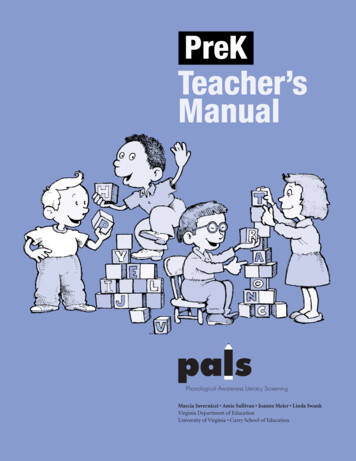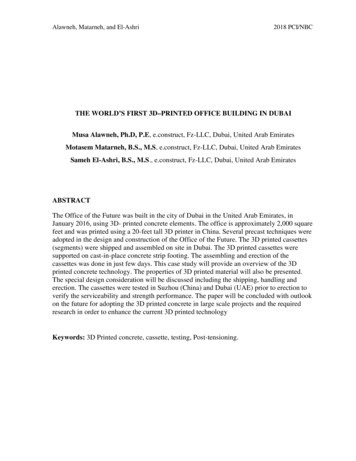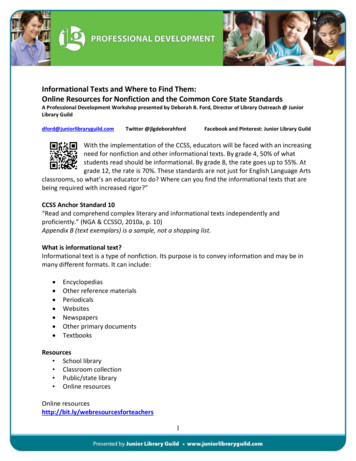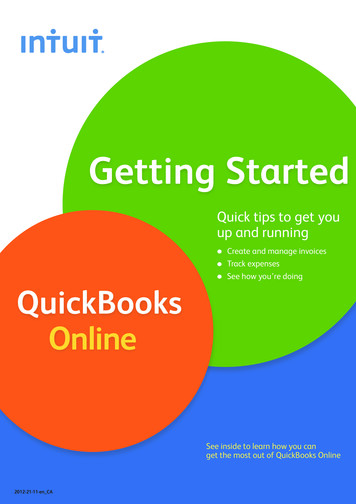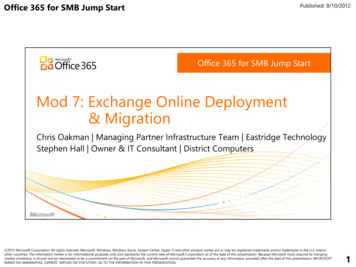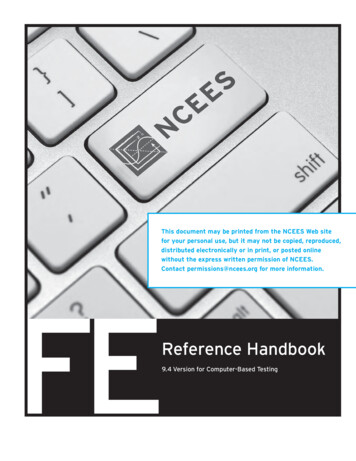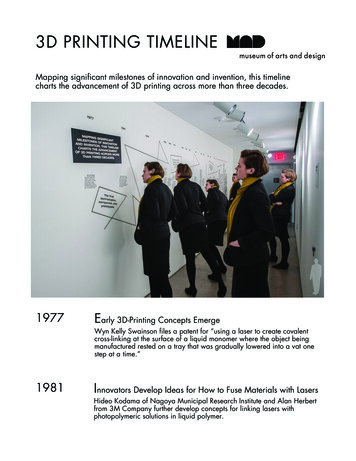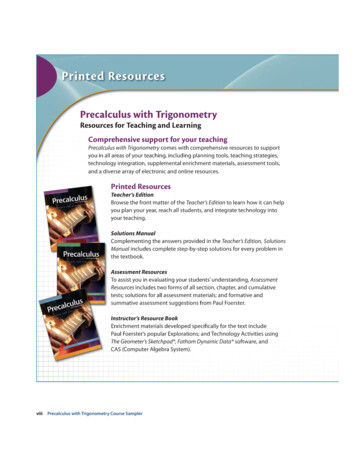
Transcription
Printed ResourcesPrecalculus with TrigonometryResources for Teaching and LearningComprehensive support for your teachingPrecalculus with Trigonometry comes with comprehensive resources to supportyou in all areas of your teaching, including planning tools, teaching strategies,technology integration, supplemental enrichment materials, assessment tools,and a diverse array of electronic and online resources.Printed ResourcesTeacher’s EditionBrowse the front matter of the Teacher’s Edition to learn how it can helpyou plan your year, reach all students, and integrate technology intoyour teaching.Solutions ManualComplementing the answers provided in the Teacher’s Edition, SolutionsManual JODMVEFT DPNQMFUF TUFQ CZ TUFQ TPMVUJPOT GPS FWFSZ QSPCMFN JOUIF UFYUCPPL Assessment ResourcesTo assist you in evaluating your students’ understanding, AssessmentResources includes two forms of all section, chapter, and cumulativetests; solutions for all assessment materials; and formative andsummative assessment suggestions from Paul Foerster.Instructor’s Resource BookEnrichment materials developed specifically for the text includePaul Foerster’s popular Explorations; and Technology Activities usingThe Geometer’s Sketchpad , Fathom Dynamic Data software, and "4 PNQVUFS "MHFCSB 4ZTUFN viiiPrecalculus with Trigonometry Course Sampler
Online ResourcesInstructor’s Resources at Key OnlineAccess the electronic version of the Student Edition and download your teachingresources for Precalculus.t Teacher’s Edition (PDF)t Solutions Manual (PDF)t Instructor’s Resource Book (PDF), includingt Assessment Resources ((Microsoft Word & PDF)Foerster’s popular Explorations,t #JMJOHVBM %JDUJPOBSZ 5FNQMBUFT GPS Blackline Masters, and Technology ActivitiesEnglish Language Learners, with space tofor Sketchpad,Sketchpad Fathom, and CASdefine mathematical terms in the student’st Sketchpad Presentation Sketchesprimary languaget %BUB TFUT JO 5* 1MVT 5* /TQJSF Microsoft Excel, and Fathom formats t 4VQQMFNFOUBSZ 1SPCMFNT BOE 4PMVUJPOTt BMDVMBUPS QSPHSBNT GPS 5* 1MVT BOE 5* /TQJSF Student EditionThe online version of the Student Edition contains all the content of the printedStudent Edition with additional features to enrich students’ learning experience.Learn more at www.keypress.com/keyonline.Student Resources at Key Math4UVEFOUT GBNJMJFT BOE UVUPST DBO BDDFTT UIF POMJOF UFYUCPPL %ZOBNJD 1SFDBMDVMVT&YQMPSBUJPOT EPXOMPBEBCMF EBUB TFUT BOE DBMDVMBUPS QSPHSBNT BOE CJMJOHVBM EJDUJPOBSZtemplates.Learn more at www.keymath.com/precalc.Precalculus with Trigonometry Course Samplerix
Flexible ContentDesign your Precalculus courseexactly the way you want it!Flexible in content and approach, Precalculus accommodates yourschool’s curriculum and standards, and it supports your teaching styleso you can meet the needs of all your students.Customize the curriculum to match your course.Course Timelines on pages xviii-xix give you options fordifferent courses that you can teach with this text—includingMath Analysis, Precalculus, Trigonometry, and more.Using This Unit and Using This Chapter give you tips onwhich sections can be abbreviated or omitted.xPrecalculus with Trigonometry Course Sampler
Flexible ApproachChoose the teaching approach thatsupports your style.Selected Explorations are incorporated into the StudentEdition; many others are provided in the Instructor’s ResourceBook. Students work in cooperative groups or independentlyto solve problems, explore patterns, and make conjecturesabout mathematical properties. Explorations also provide richdiscussion opportunities for whole-class participation.Detailed teaching notes and clear examples support alecture-based approach.This curriculum also includes journal prompts, structuredreviews, projects, computer-based activities, and webbased Dynamic Precalculus Explorations.Precalculus with Trigonometry Course Samplerxi
AssessmentEvaluate your students’ progressand understanding.Precalculus helps you evaluate your students’ learning comprehension witha range of formative and summative assessment tools, including readinganalysis, quick review, self-assessment, and section and chapter tests.Reading Analysis allows you to quickly determine if studentsunderstand the content of the lesson and can verbally express thatunderstanding. Journal entries provide additional insight intostudent understanding. Additional reading and reflecting strategiesalso help your students develop into independent learners, preparingthem for college and more advanced math courses.Quick Review builds efficiency and increases retention of requiredskills. You can assess students’ retention of prerequisite concepts,and your students will build fluency in solving routine problemsquickly, a skill they will use when taking standardized tests.xiiPrecalculus with Trigonometry Course Sampler
AssessmentSelf-assessment is encouraged throughout Precalculus. Studentscan demonstrate mastery with Quick Review and Reading Analysisproblems, Chapter Review sections, practice Chapter Tests withcalculator and no-calculator portions, and Cumulative Review sections.Tests in Assessment Resources are offered in Forms A and B, withcalculator and no-calculator portions.Formative assessment is supported by Section Notesin the Teacher’s Edition.On-page answers in the Teacher’s Edition allow you toquickly check correctness of answers.Precalculus with Trigonometry Course Samplerxiii
Differentiated InstructionSupport strong conceptual developmentfor ALL your students.The accessibility of the mathematics in Precalculus is central to its design.Precalculus combines varied forms of pedagogy and instructionalstrategies to engage, challenge, and motivate all learners—strugglingstudents, English Language Learners, and advanced learners alike.Multiple representationsmake the mathematicsaccessible to more learners.Each concept is clearly developedthrough graphical, algebraic,numerical, and verbalrepresentations. This approachhelps you reach more learnersand better prepares students forAP Calculus.An investigative approach issupported with Explorationsin the Student Edition and in theInstructor’s Resource Book.Sketchpad Presentation Sketches,Dynamic Precalculus Explorations,and other technology activitiesallow for multiple approaches tounderstanding a topic.xivPrecalculus with Trigonometry Course Sampler
Differentiated InstructionLiteracy strategies and notes for differentiating instructionare integrated throughout this curriculum.Reading Analysis questions help students develop the literacy skills theyneed to succeed in high school, college, and beyond.Journal prompts ask students to note their questions and observations aboutthe topics they have been studying. By keeping a journal and sharing entriesin class, students improve their ability to express themselves mathematically,both orally and in writing.Notes for differentiating instructionprovide insight into areas where studentsmight struggle with concepts or languageand suggest pre-reading and otherstrategies to help them succeed.Bilingual dictionary templates, found atwww.keypress.com/keyonline (for teachers)and www.keymath.com/precalc (forstudents), help ELL students acquire themathematical vocabulary they need.Precalculus with Trigonometry Course Samplerxv
Online ResourcesEnhance your teaching with online resources.Helpful online resources for both teachers and students includesupplementary problems, calculator programs, and an enhanced onlinetextbook—accessible whenever you need them.Key Online: Resources for TeachersAt Key Online you’ll find extensive resourcesto support your teaching and your students’learning. t "DDFTT FMFDUSPOJD WFSTJPOT PG ZPVS teachingresources, including assessment materialsand PDFs of the Teacher’s Edition. t 'JOE supplementary problems and solutions. t 4QBSL MFBSOJOH JO ZPVS DMBTTSPPN XJUIpresentations and activities usingThe Geometer’s Sketchpad .Learn more at www. keypress.com/keyonline.SketchThe following sketch shows a unit circle in the uv-coordinate system with angles of measure x and 2x radians. The uvcoordinate system is superimposed on an xy-coordinate system with sinusoids y sin x in red and y sin 2x in blue.Investigate1. Drag the black point to change the value of x. What length on the unit circle does x correspond to?What length does 2x correspond to?2. How do the (u, v) coordinates of each point correspond to the (x, y) coordinates of points on the sinusoids?3. Press the Show Lines button. Explain why the red and blue horizontal lines intersect thesinusoids where they do. Does this confirm or change your answer to question 2?4. Do the moving points on the sinusoids have the same value of x?xviPrecalculus with Trigonometry Course Sampler
Online ResourcesKey Math: Resources for StudentsSketchDrag the sliders to change the values of the parameters A, B, C, and D in the function d(t) C A cos B(t D).Investigate1. The waterwheel rotates at 6 revolutions per minute (rpm). Two seconds after you start astopwatch, point P on the rim of the wheel is at its greatest height, d 13 ft, above the surfaceof the water. The center of the waterwheel is 6 ft above the surface. Based on this information,write an equation expressing the height of point P as a function of time.2. Drag the sliders for A, B, C, and D so that the function d matches the one you wrote in question 1.Press Show Graph of d, and then press Rotate Wheel to see if your solution matches the motion ofthe waterwheel. If not, readjust the sliders to obtain a function that matches.At Key Math students will find engaging activities and resources. t "DDFTT BO FOIBODFE online textbook. t *OWFTUJHBUF Dynamic Precalculus Explorations. t %PXOMPBE calculator programs GPS VTF XJUI 5* /TQJSF BOE 5* 1MVT HSBQIJOH DBMDVMBUPST t %PXOMPBE data sets GPS VTF XJUI 5* /TQJSF 5* 1MVT graphing calculators, Excel, and Fathom . Learn more at www.keymath.com/precalc.Precalculus with Trigonometry Course Samplerxvii
TechnologySpark mathematical thinkingwith technology.Precalculus fully integrates technology to help you illustrate difficultconcepts and to give students the opportunity to explore ideas, drawmathematical conclusions, and test hypotheses. With this curriculumyou can bring everyday relevance to abstract concepts, sparkmathematical thinking, and prepare students for AP Calculus.Students use graphing calculatorsevery day to visually explorefunctions and other topics,investigate real-world applications,and prepare for AP Calculus.Optional CAS Suggestions in theTeacher’s Edition help you integratethe use of CAS technology.Additional CAS Problems enhancethe problem set for students usinga CAS, while CAS Activities providemore in-depth exploration ofconcepts.xviiiPrecalculus with Trigonometry Course Sampler
TechnologyTechnology Notes suggest waysyou can enrich your course withthe use of Sketchpad or Fathom .They also provide guidance forusing calculator programs.Dynamic Precalculus Explorations,available at www.keymath.com/precalc,help students investigate a variety ofconcepts in the Student Edition.Precalculus Presentation Sketches,available online, let you presentconcepts visually and dynamicallywith Sketchpad.Precalculus with Trigonometry Course Samplerxix
Course PlanningPlan your course with exceptional teachingand technology resources.Precalculus facilitates course planning with flexible timelines, extensiveteaching notes, and easy access to teaching and technology resources.Interleaf pages at the beginning of each chapter provide valuableinformation for planning, including a chapter overview, pacing guides,a list of teaching and technology resources, and a brief description ofwhich sections in the chapter can be skipped if time is limited.xxPrecalculus with Trigonometry Course Sampler
Course PlanningPacing Guides at the start of each chapter help you plan.Section Notes give extensive guidance for teaching each sectionand Problem Notes give tips and background on the conceptsbehind many problems.Important Terms and Concepts are noted at the beginning ofeach section.Precalculus with Trigonometry Course Samplerxxi
AP Calculus PreparationEngage students, maximize theirunderstanding of Precalculus, andprepare them for AP Calculus.Students love this textbook because it is written with their interests andneeds in mind. Author Paul Foerster draws on 50 years of classroomteaching experience and student feedback to give students exactly whatthey need to succeed in this course and be prepared for AP Calculus.Objectives are stated in every section.Important properties, definitions, techniques, andprocedures are called out in the text.Graphing calculator use is modeled in examples.Chapter Review, Chapter Test, and Concept Problems helpstudents assess their own understanding, prepare for testing, andexplore concepts further.Glossary, Answers to Selected Problems, and a quick referenceto important formulas appear in the back of the book, givingstudents extra support.Problem Sets, found at the end of each section, include bothconceptual problems and problems for drill and practice, to helpstudents prepare for Calculus.xxiiPrecalculus with Trigonometry Course Sampler
Quick-Reference IconsReading Analysis questionsteach students how to read amathematics book by asking themto summarize the main ideas of thesection in their own words.Quick Review problemsget students used to doingroutine things quickly.5minCalculator notes provide tipson using graphing calculators.CAS notes and problemshelp you integrate CAS intoyour curriculum.Enrich learning with DynamicPrecalculus Explorations atwww.keymath.com/precalc.Enhance learning with Sketchpad presentation sketchesand activities.Dynamically explore datawith Fathom activities.Refer to the Internet to answera question, complete an activity,or look for more information.Examples of student work modelproblem solutions.Foerster’s top three tips for success:t Use multiple representations to engage all students.t Assign Quick Review problems to refresh skills as needed and givestudents practice doing routine problems quickly, an important skillfor standardized tests.t Start with an Exploration to make learning math fun.Precalculus with Trigonometry Course Samplerxxiii
xii Precalculus with Trigonometry Course Sampler Precalculus helps you evaluate your students’ learning comprehension with a range of formative and summative assessment tools, including reading analysis, quic
